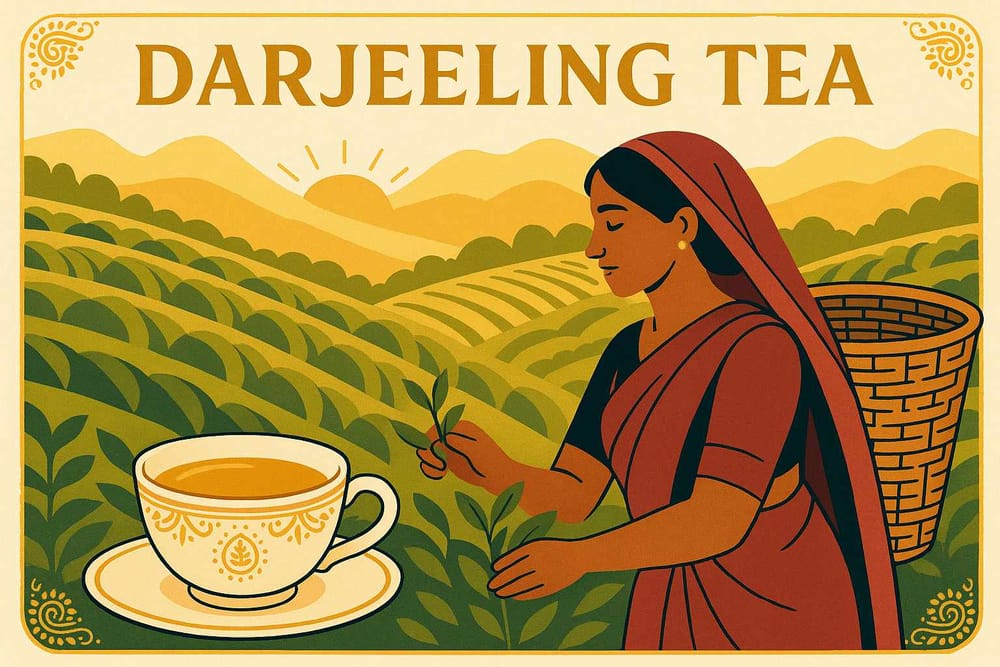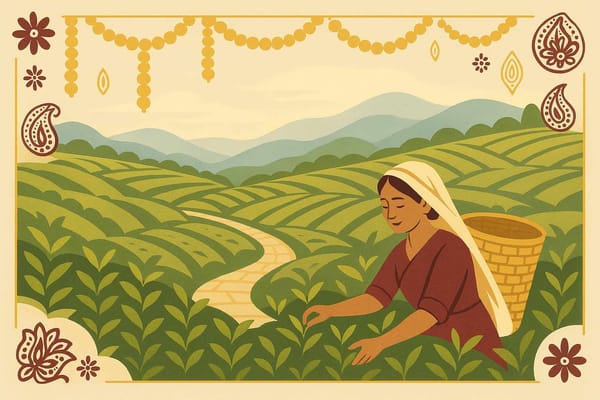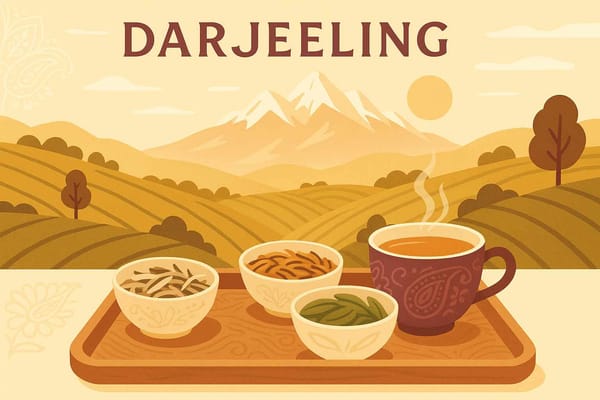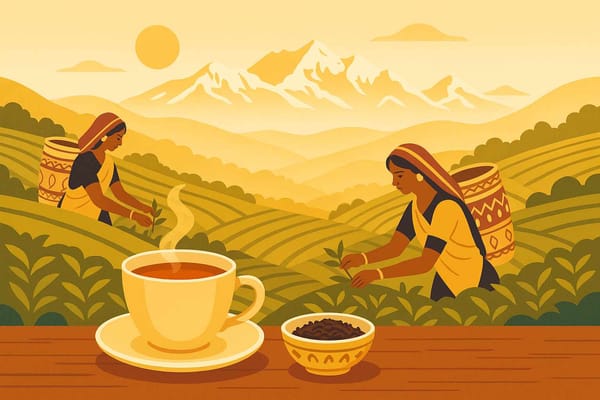
The Rich Legacy and Unique Flavors of Darjeeling Tea - Explained
There’s something magical about a warm cup of tea, isn’t there? It’s more than just a drink. It’s a moment of peace, a comforting friend on a rainy afternoon, and a silent companion during late-night conversations. For me, and for many of us in India, that perfect cup often holds the delicate, aromatic essence of Darjeeling. Have you ever wondered what story each sip tells? It's a tale that begins in the misty, cloud-kissed hills of West Bengal, a story of nature, human hands, and a legacy that has been cherished for generations.
Often called the "Champagne of Teas," Darjeeling tea is not just a beverage; it’s a piece of our heritage. Let's take a journey together to discover why this exquisite tea is so revered, from its colonial beginnings to its cherished place in our hearts today.
A Legacy Planted in History
The story of Darjeeling tea takes us back to the 1840s. It all started with a vision by Dr. A. Campbell, a British surgeon who first experimented with planting tea seeds in his garden in Darjeeling. He saw the potential in the region's cool climate and sloping terrain, and he was right! By the mid-19th century, commercial tea gardens began to blossom, transforming the serene Himalayan foothills into a world-famous tea-producing region.
But this transformation wouldn't have been possible without the tireless efforts of Gorkha laborers. Their hard work, dedication, and traditional knowledge of the land nurtured these gardens into life. These skills have been lovingly passed down through generations, and it is this human touch that preserves the authentic soul of Darjeeling tea. This dedication to preserving a legacy is a thread that runs deep in our culture, visible everywhere from the tea gardens of Darjeeling to the timeless arts and crafts of Mewar.
In 2004, this incredible legacy received a special honour: Darjeeling tea became the first Indian product to be awarded the Geographical Indication (GI) tag. This isn’t just a label; it’s a promise of authenticity. It ensures that only tea grown in the 87 designated gardens of Darjeeling can carry its prestigious name, protecting its heritage from imitation and celebrating its unmatched quality on the world stage.

The Magic of the Mountains: Where Flavour is Born
Many people wonder, what is it that gives Darjeeling tea its special, almost magical, flavour? The secret lies in its unique home, or what experts call "terroir." Nestled in the Himalayan foothills, these tea gardens are perched at high altitudes, between 600 and 2,000 meters. The cool mountain air, plentiful rainfall, and rich, well-drained soil create the perfect conditions for tea bushes to thrive.
The constant mist that blankets the hills plays a crucial role. It gently filters the sunlight, slowing down the growth of the tea leaves. This slow process allows the leaves to develop a complex and concentrated flavour. It's this unique interplay of nature that gives Darjeeling tea its world-famous muscatel note—a delightful, grape-like sweetness with a hint of floral nuttiness that you won’t find in any other tea.
Because of these specific conditions, only about 10 million kilograms are produced each year. This rarity, combined with the meticulous cultivation, is why authentic Darjeeling tea is considered a premium beverage, a true treasure from the Himalayas.
The Artistry in Every Leaf: A Labour of Love
Creating a perfect cup of Darjeeling tea is an art form, a delicate dance between human hands and nature. The journey begins with skilled pluckers, mostly women, who carefully select only the "two leaves and a bud"—the most tender and flavourful part of the plant. Their hands move with a gentle swiftness that comes from generations of practice.
Once plucked, the leaves go through a traditional process known as the orthodox method, which is crucial for developing their unique aroma and taste.
- Withering: The leaves are spread out to lose moisture, becoming soft and pliable. This is the first step in concentrating their flavour.
- Rolling: The withered leaves are gently rolled to break open their cell walls, releasing the natural juices and enzymes that will create the tea's character.
- Oxidation (Fermentation): This is where the magic truly happens. The leaves are left to rest in a climate-controlled room, where they react with oxygen. This step develops the tea’s rich colour and complex flavour profile.
- Drying: Finally, the leaves are dried with hot air to stop the oxidation process and lock in their delicate aromas.
This careful, time-honoured process ensures that every sip of Darjeeling tea carries the true essence of its mountain home.

A Symphony of Seasons: Understanding the Flushes
Darjeeling tea is not just one single flavour; it changes with the seasons, offering a different experience with each harvest, or "flush."
- First Flush (Spring): Harvested from March to April, this is the first crop after the winter dormancy. The liquor is light, the aroma is fresh and floral, and the taste is crisp and delicate. It’s often the most prized and expensive flush.
- Second Flush (Summer): Picked from May to June, this flush is famous for its prized muscatel flavour. The leaves produce a fuller-bodied, amber-coloured liquor with distinct fruity and nutty notes. Many consider this the quintessential Darjeeling experience.
- Monsoon Flush (Rainy Season): Harvested during the rainy months, this tea is stronger and bolder in flavour. While less nuanced than the first two flushes, it’s perfect for making robust blends and iced tea.
- Autumn Flush (Post-Monsoon): This harvest, from October to November, yields a tea with a smooth, mellow character and a deeper, coppery hue. It offers a wonderful balance of richness and subtlety.
Beyond these flushes, you can also find exquisite White, Green, and Oolong Darjeeling teas, each processed differently to offer a unique taste of the Himalayas.
Facing the Future: Protecting Our Precious Heritage
This cherished legacy is not without its challenges. Climate change has brought unpredictable weather, affecting the quality and quantity of the harvest. Landslides and labour shortages also pose a threat to these historic gardens. Furthermore, cheaper imitations from neighbouring regions try to ride on Darjeeling's famous name.
But the spirit of Darjeeling is resilient. Researchers are developing climate-resilient tea clones to safeguard future crops. There is a strong push to enforce the GI tag strictly to guarantee authenticity. These efforts are not just about protecting a product; they are about preserving the livelihoods, culture, and heritage of an entire region.
Connecting with Our Roots Through Tradition
Understanding these traditions, whether it's the art of tea-making or ancient rituals, helps us connect with our roots on a deeper level. At Bhaktilipi, we are dedicated to this very purpose. We strive to bring you authentic stories and knowledge that bridge our rich past with our modern lives, making our heritage accessible to everyone. Much like a soulful journey through a historic city like Udaipur reveals layers of tradition, exploring the story of Darjeeling tea uncovers a world of dedication and artistry.
For more inspiring content that connects you to our culture, follow us on Facebook, Instagram, and YouTube. Join our community and let's explore our beautiful heritage together.
Savouring the Legacy in Your Cup
So, the next time you brew a cup of Darjeeling tea, take a moment. As the steam rises, remember the misty mountains, the skilled hands, and the timeless tradition it represents. To get the best taste, use fresh, filtered water just short of boiling and let the leaves steep for 3-5 minutes. Watch as the water transforms into a beautiful golden or amber liquid.
With each sip, you are not just drinking tea. You are tasting a story—a story of heritage, harmony, and the incredible spirit of the Himalayas. It’s a celebration of a legacy that continues to connect us all, one beautiful cup at a time.
A passionate group of people dedicated to preserving India's knowledge of Dharma, Karma, and Bhakti for ourselves and the world 🙏.
Comments
Related in

Explore Unique Flavors-Darjeeling Tea: A Journey Through Tea Gardens
Have you ever held a cup of chai that felt like it was whispering secrets of the mountains? For me, that magical experience is Darjeeling tea. It’s more than just a drink; it's a feeling, a warm hug on a misty morning, a story steeped in every

The Unseen Varieties of Darjeeling Tea: White to Golden Tips Explained
Close your eyes for a moment. Can you feel the cool Himalayan mist on your skin? Can you smell that fresh, earthy scent after a light drizzle on the mountainside? That, my friend, is the very soul of Darjeeling, and it’s captured perfectly in a single cup of its

Exploring Darjeeling Tea-History and Flavors
Have you ever held a warm cup of tea, closed your eyes, and felt transported to another place? For me, a cup of authentic Darjeeling tea does just that. It’s not just a beverage; it's an experience. With every sip, you can almost feel the cool mist
